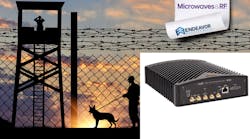Detecting and Locating Cell Phones in Prisons
This article appeared in Microwaves & RF and has been published here with permission.
What you’ll learn:
- It’s rather difficult to prevent contraband wireless devices from entering prisons.
- Detection and location are time- and resource-intensive; jamming poses other safety issues.
- Real-time spectrum analysis coupled with analysis software is one possible solution.
Cell phones and other connected devices have become a major problem for prisons around the world. In the United States, Congress has passed the Contraband Cell Phone Act, which prohibits the possession of cell phones in prisons by unauthorized persons, including inmates.
Cell phones make it possible for prisoners to communicate with people outside the prison, and to transmit text, video, or other data, potentially coordinating crimes or purchasing additional contraband. These activities jeopardize the safety and security of other prisoners, prison guards, staff, and the public.
The Challenge
Given the large inmate populations, it’s extremely difficult to prevent cell phones from entering a prison in the first place. Cell phones are small and often not picked up by metal detectors. As with all contraband brought into prisons, a wide variety of tactics are used to circumvent security measures, including bribing guards, having items thrown over the fence, or, increasingly, dropping packages from drones that fly undetected over the prison.
Prevention techniques used to find and/or disable cell phones carry legal or practical issues that limit their viability and effectiveness. Random searches and pat-downs require time and resources and can easily miss contraband when dealing with many people. Jamming techniques that prevent phones entirely from transmitting face legal barriers, and they have the potential to disrupt connectivity for guards, emergency services, or people in the areas adjacent to the facility.
Still, prisons need to be able to detect that a cell phone is present, determine its exact location, and dispatch guards to find and confiscate it.
The Solution
One tool that can give an institution’s personnel a full view of the spectrum environment is a real-time spectrum analyzer. As an example, thinkRF’s R5550 real-time spectrum analyzer is a compact, versatile, and remote deployable instrument that supports advanced analysis capabilities and indoor geolocation to pinpoint the location of an illegal device (see figure). It’s easily integrated with third-party software for deeper analysis.
One advantage of an R5550 analyzer is that it’s networked and designed for remote deployment. To detect signals, prisons place several units around the facility and monitor them from a centralized location. This gives guards a continuous, 24/7 view of the spectrum and makes it easy to identify signals coming from a specific cell or area in the yard.
The analyzers can also alert prison staff to the presence of drones by detecting the RF signals used to control the vehicles. Guards can then check for any contraband dropped by the vehicles and confiscate it before it’s collected by inmates. This further increases the facility’s safety and security.
Leveraging the capabilities of the thinkRF R5550 analyzer and advanced analysis third-party software, prisons can detect and locate cell phones or other wireless devices used by inmates. In turn, prisons are safer due to the reduction in contraband and other illegal activities.

